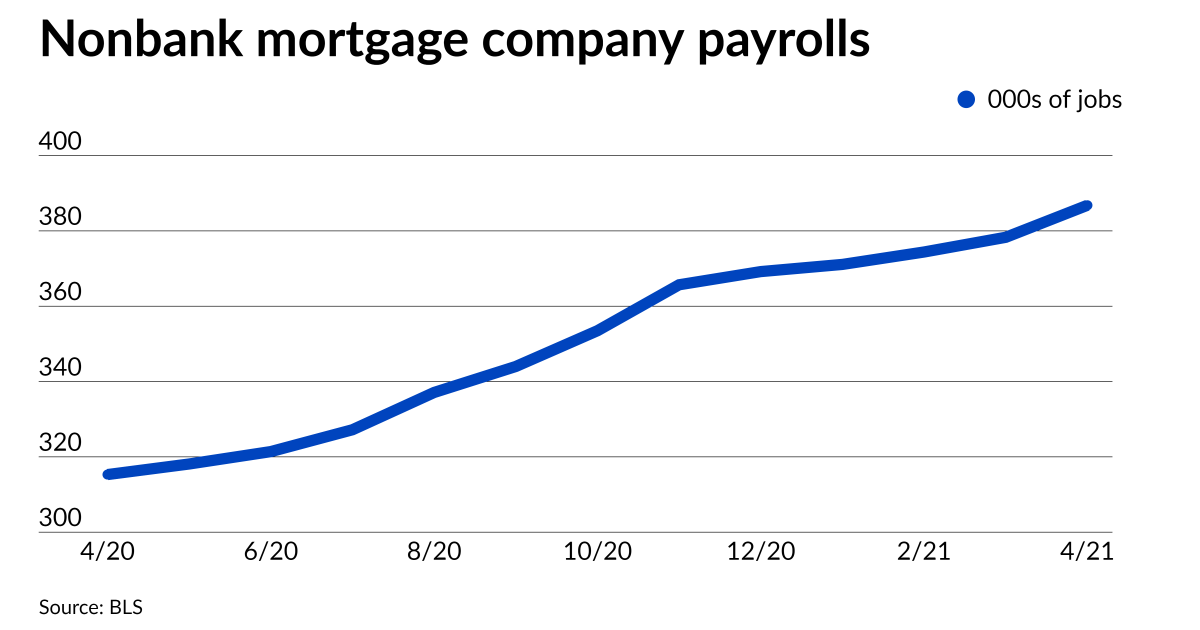
Nonbank mortgage employment inched up in April and remained historically strong, according to the Bureau of Labor Statistics.
There were an estimated 386,800 people on mortgage banker and broker payrolls, compared to 378,300 the previous month. Broader U.S. job numbers that were reported with less of a lag show 559,000 jobs were added in May, below consensus estimates anticipating a number above 600,000.
The more gradual upward drift in job numbers this year may hint at a slight softening in the market that analysts have flagged. While profitability in home lending is still roughly double its historical average since 2008, it dropped the past two quarters, according to a recent Mortgage Bankers Association report.
“Looking ahead, we expect gain-on-sale margins to contract further in the coming quarters,” Bose George, Thomas McJoynt-Griffith, and Michael Smyth, analysts at Keefe, Bruyette & Woods, said in a recent report.
With residential construction eking out some gains in the May jobs report amid a wave of spring homebuying, it is possible that mortgage hiring could turn out to look stronger when later numbers are released. April estimates for overall U.S. jobs did undergo an upward revision by 12,000 on Friday. March numbers for total employment also underwent an upward revision by 15,000. Unusually strong refinance numbers through March also may be playing a role in softening the relative gains seen this spring.
Some indicators suggest there’s been slight improvement in the housing market over the course of the past month.
“The number of residential building construction workers increased 0.5% in May. Home building requires manual labor as a key input into the production process, so this is a step in the right direction,” First American Deputy Chief Economist Odeta Kushi said in an emailed press statement on Friday.
However, even with this increase, there are still labor shortages in construction that could continue to constrain the extent to which the home-purchase market can make up for declines in refinancing seen subsequent to the first quarter.
“Residential construction employment, including specialty trade contractors, rose just 1,900 in May, a slower pace than in previous months, and a pace not fast enough to ease supply constraints present in this sector,” Fannie Mae Chief Economist Doug Duncan said in an emailed press statement.
The high cost of building materials, which limits the supply of new homes, has also constrained mortgage origination in the home purchase market. The price of materials rose somewhere between 20 and 30% in the past 12 months, according to the most recent Housing Market Index report released by the National Association of Home Builders and Wells Fargo.
The overall unemployment rate could limit home purchases slightly as well. Unemployment fell 0.3% to 5.8% but remains elevated compared to historical lows below 4% prior to the pandemic. Also, since March 2020, there’s been a misclassification error that has affected unemployment numbers, and the estimated adjustment for that error in May may have been as high as 0.3%.
However, economists are generally still forecasting a continued drop in unemployment in 2021 due to the vaccine rollout and the slow removal of social distancing restrictions.
“MBA is sticking with our forecast of a 4.5% unemployment rate by the end of the year,” Chief Economist Mike Fratantoni said in a press statement on Friday.



